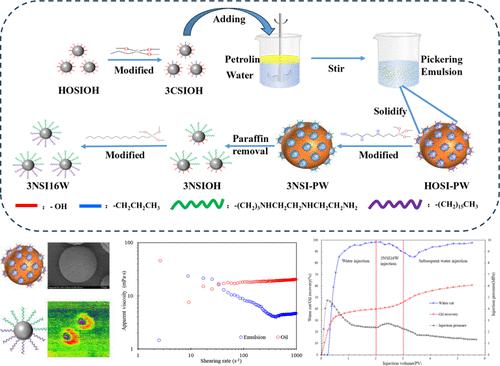Our official English website, www.x-mol.net, welcomes your feedback! (Note: you will need to create a separate account there.)
Design of Janus Nanoparticles for Mobility Control in Heterogeneous Reservoirs
ACS Omega ( IF 4.1 ) Pub Date : 2024-03-26 , DOI: 10.1021/acsomega.4c00317 Long Zang 1 , Miaomiao Hu 1, 2 , Jie Cao 1 , Yun Cheng 1 , Pengpeng Li 1 , Jintang Guo 1, 2 , Hang Zhang 1
ACS Omega ( IF 4.1 ) Pub Date : 2024-03-26 , DOI: 10.1021/acsomega.4c00317 Long Zang 1 , Miaomiao Hu 1, 2 , Jie Cao 1 , Yun Cheng 1 , Pengpeng Li 1 , Jintang Guo 1, 2 , Hang Zhang 1
Affiliation

|
Unfavorable mobility ratios in heterogeneous reservoirs have resulted in progressively poor waterflood sweep efficiency and diminishing production. In order to address this issue, our study has developed amphiphilic-structured nanoparticles aimed at enhancing the microscopic displacement capability and oil displacement efficiency. First, the transport process of Janus nanoparticles in porous media was investigated. During the water flooding, Janus nanoparticle injection, and subsequent water flooding stages, the injection pressure increased in a “stepped” pattern, reaching 0.023, 0.029, and 0.038 MPa, respectively. Second, emulsification effects and emulsion viscosity experiments demonstrated that the amphiphilic structure improved the interaction at the oil–water interface, reducing the seepage resistance of the oil phase through emulsification. In porous media, Janus nanoparticles transported with water exhibit ‘self-seeking oil’ behavior and interact with the oil phase, reducing the viscosity of the oil phase from 19 to 5 mPa·s at 80 °C. Finally, the core model displacement experiment verified the characteristics of Janus nanoparticles in improving the oil–water mobility ratio. Compared with the water flooding stage, the recovery percent increased by 20.8%, of which 13.7% was attributed to the subsequent water flooding stage. Utilizing the asymmetry of the Janus particle structure can provide an effective path to enhanced oil recovery in inhomogeneous reservoirs.
中文翻译:

用于非均质油藏流度控制的 Janus 纳米粒子设计
非均质油藏中不利的流度比导致水驱波及效率逐渐变差并导致产量下降。为了解决这个问题,我们的研究开发了两亲结构纳米颗粒,旨在提高微观驱油能力和驱油效率。首先,研究了 Janus 纳米颗粒在多孔介质中的传输过程。在水驱、Janus纳米颗粒注入以及随后的水驱阶段,注入压力呈“阶梯式”上升,分别达到0.023、0.029和0.038 MPa。其次,乳化效应和乳液粘度实验表明,两亲结构改善了油水界面的相互作用,通过乳化降低了油相的渗流阻力。在多孔介质中,随水传输的 Janus 纳米粒子表现出“自寻油”行为并与油相相互作用,将 80 °C 时油相的粘度从 19 mPa·s 降低至 5 mPa·s。最后通过岩心模型驱替实验验证了Janus纳米颗粒改善油水流度比的特性。与水驱阶段相比,采收率提高了20.8%,其中13.7%归因于后续水驱阶段。利用Janus颗粒结构的不对称性可以为非均质油藏提高采收率提供有效途径。
更新日期:2024-03-26
中文翻译:

用于非均质油藏流度控制的 Janus 纳米粒子设计
非均质油藏中不利的流度比导致水驱波及效率逐渐变差并导致产量下降。为了解决这个问题,我们的研究开发了两亲结构纳米颗粒,旨在提高微观驱油能力和驱油效率。首先,研究了 Janus 纳米颗粒在多孔介质中的传输过程。在水驱、Janus纳米颗粒注入以及随后的水驱阶段,注入压力呈“阶梯式”上升,分别达到0.023、0.029和0.038 MPa。其次,乳化效应和乳液粘度实验表明,两亲结构改善了油水界面的相互作用,通过乳化降低了油相的渗流阻力。在多孔介质中,随水传输的 Janus 纳米粒子表现出“自寻油”行为并与油相相互作用,将 80 °C 时油相的粘度从 19 mPa·s 降低至 5 mPa·s。最后通过岩心模型驱替实验验证了Janus纳米颗粒改善油水流度比的特性。与水驱阶段相比,采收率提高了20.8%,其中13.7%归因于后续水驱阶段。利用Janus颗粒结构的不对称性可以为非均质油藏提高采收率提供有效途径。



























 京公网安备 11010802027423号
京公网安备 11010802027423号